Set halfway between Pisa and Florence, the medieval town of San Miniato is about the sleepy mood and the tasty food. Crowning three hills, San Miniato surveys magnificent countryside. On the proverbial fine day you can gaze as far as Volterra and the Apuan Alps from the top of the hill. The lofty fortress, the rebuilt Rocca, stands guard over San Miniato and is the city symbol. The historic heart of town is delightful and much-underrated. Come for the cobbled streets, the sinuous facades, the handsome mansions and medieval churches. San Miniato is the perfect antidote to the excessive tourism in Tuscan towns such as San Gimignano. Heritage aside, to most Italians, San Miniato means one thing only: white truffles. The town produces a quarter of Tuscany's crop, even if many end up in the best local inns. An autumn visit will show you what the fuss is all about.
San Miniato
-
-
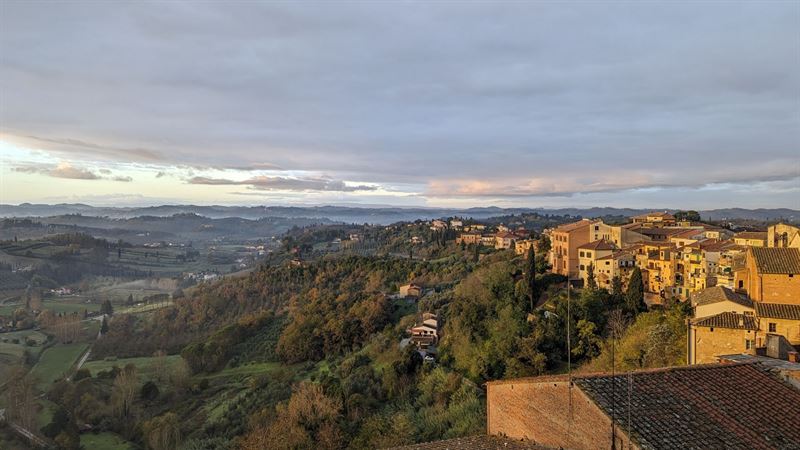
Top Ten Things to Do
San Miniato is all about mood and minor sights, along with major eating. San Miniato also makes a great base. If suffering from cultural overload, head to a cosy inn, a day spa or go bird-watching in the moody marshlands, the Padule di Fucecchio. For city life and cultural enlightenment, head to Pisa, to the west, or Florence, to the east, along with Lucca, San Gimignano and the Tuscan coast at Marina di Pisa – all are appealingly arty day trips.
-
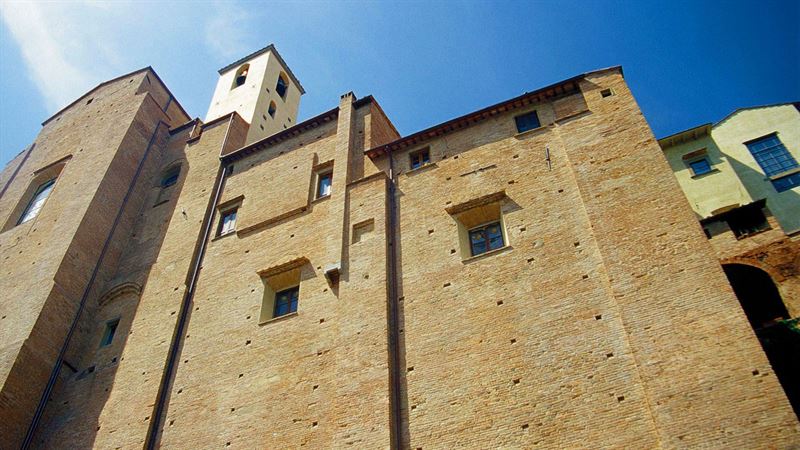
1. San Miniato stroll
As the most attractive hilltop town between Pisa and Florence, San Miniato is definitely worth exploring. The fate of the town has always been closely linked to its geographical position. San Miniato is pretty much equidistant from the important cities that shaped Tuscan history: Pisa, Florence, Lucca, Pistoia, Siena and Volterra. Even if the urban mood is medieval, the town’s origins go back to Etruscan and Roman times. This charming hilltop town, slightly off the beaten track, rose to prominence under Swabian (German) emperors.
High on the hillside is the Rocca di Federico II, which was built by the Holy Roman Emperor Frederick II in around 1220 to complete the town’s defensive system. Given its seemingly impregnable position, the fortress became the Imperial headquarters, not just for Tuscany but for the whole of Central Italy. Then San Miniato quietly sank into oblivion until rudely awaked in modern times. As the town was a German stronghold during the Second World War, the retreating Nazis mined key sections: part of San Miniato was destroyed but rebuilt, including the city beacon, the Rocca.
San Miniato’s harmonious medieval town centre still boasts Renaissance mansions, several of which have become banks. One such is the splendid Renaissance mansion of Palazzo Grifoni, which marked the first time the medieval city walls were modified. Although the mansion was mined by the Nazis, it was subsequently fully restored in the 1990s. Another architectural highlight is the impressive Piazza del Seminario, framed by the Seminario Vescovile, the Episcopal Palace. Its sinuous, frescoed façade follows the line of the medieval town walls. In medieval times, San Miniato was an important stop on the Via Francigena pilgrimage route and has a clutch of intriguing churches to prove its past status. Look out for the much-remodelled red-brick Cattedrale di Santa Maria Assunta. There’s also the church of San Francesco, built by the Lombards in the 8th century, and the oldest surviving building in town.
Address: San Miniato tourism: Piazza del Popolo 1, 56028 San Miniato
Tel: +39 57142745
Web: www.sanminiatopromozione.it -
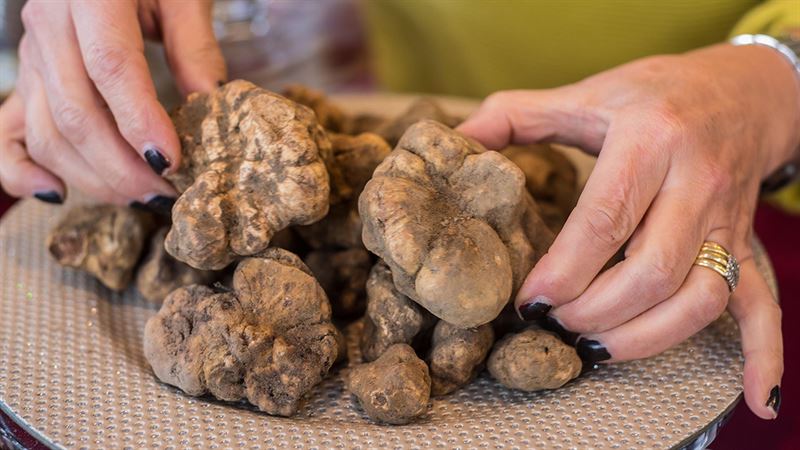
2. Tasting Truffles in San Miniato
San Miniato is Tuscany’s major truffle capital so this is the place to breathe in the scent of truffles, enjoy a truffle feast, and maybe even go on a simulated truffle hunt. The town is famous for the highly prized white truffle (Tuber Magnatum Pico). The 400-odd official truffle-hunters, known as tartufai, still dream of discovering a record-breaking truffle. San Miniato boasts the discovery of the biggest truffle ever found, a tuber weighing over two kilos unearthed in 1954.
The truffling season runs from mid-September to Christmas but peaks in November. Sniffed out by dogs, the truffle is dug out of the ground with a type of pole called a vangheggia. Given that the truffles are found in the same place every year, the individual truffle-hunters are naturally very secretive about their patches. Their secrets are handed down through the generations, ensuring that their hidden trails in the holm oak and poplar woods remain secret. The Association of Truffle-hunters of the San Miniato Hills is fiercely protective of their interests. Even so, you can take the opportunity to join a simulated truffle hunt, booked through the tourist office or independently. Book a truffle hunt through Barbialla Nuova, on their local estate, with the experience ending in a wine-and-cheese tasting.
In November for three weekends, the medieval town of San Miniato becomes the capital of white truffles. This period represents the peak of the white truffle season, when these tasty tubers are at their very best. The White Truffle Festival, known as the Mostra Mercato Nazionale del Tartufo Bianco di San Miniato, draws over a hundred thousand visitors to its celebrations. During the festival, chefs set up open-air tasting stations, focusing on autumnal fare and foodie trends. The best truffle dish is probably the simplest, the classic tagliolini al tartufo bianco, pasta with white truffles. Even so, local truffle dishes can be creative, such as crepe stuffed with ricotta and walnut in a truffle sauce. La Taverna dell’Ozio is a good place to try truffle dishes.
Fondazione San Miniato Promozione, Piazza del Popolo 1, 56028 San Miniato
www.sanminiatopromozione.it
Tel: +39 571 42745
Address: Barbialla Nuova-truffeljacht, via Casastada 49, Montaione.
Tel: +39 0571 677 004
www.barbialla.it
-
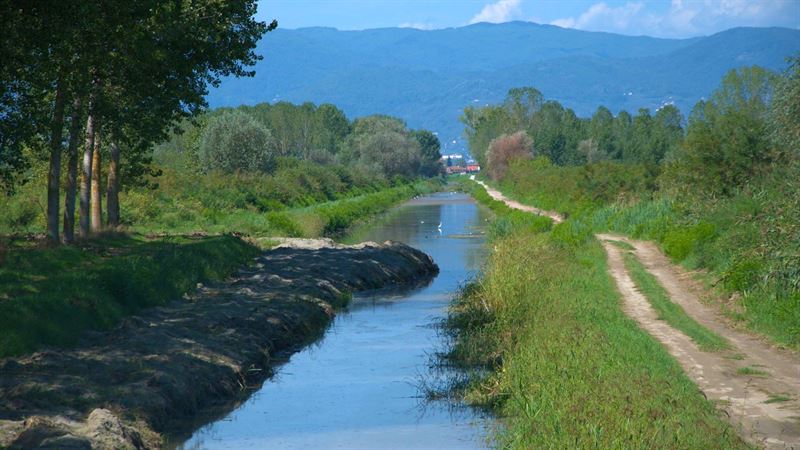
3. Birdwatching in the Fucecchio marshlands
Just 6km north of San Miniato await the mysterious marshlands known as the Padule di Fucecchio, to the north of Fucecchio. These ancient wetlands are the last remaining tract of the extensive marshes that once stretched from the Arno Valley in the south to the Pistoian Apennines to the north. These wetlands are still Italy’s biggest inland marsh, covering about 1,800 hectares, even if only 230 hectares are fully protected as a designated nature reserve.
In medieval times, the marshes were fishing grounds, with eels the main catch, which continued under Florentine Medici rule in the 16th century. The Padule di Fucecchio marshes were Medicean fishing grounds, and Cosimo I had a bridge and weirs built to facilitate the sport. The monumental Medici bridge, the Ponte a Cappiano, still survives as a testament to these times. Much of the marshes were later drained by the Tuscan Grand Dukes in the 1780s, leaving what we have today. This area is still considered a major wetland centre, all the more important as it lies close to industrialised parts of Tuscany. The marshland habitat attracts over 200 species of birds, including cranes, black storks, marsh falcons and the most important heron nesting colony in central and southern Italy. In addition, you can spot ducks, coots and wintering water birds.
Near the Castelmartini visitor centre in Larciano (Centro Padule di Fucecchio) is a path framed by weeping willows and poplars, with guided walks available if booked in advance. Serious birdwatchers consider March to mid-June the best period for spotting birds, particularly as the vegetation then helps conceal visitors. SOS Tuscan Wetlands is battling to reverse the drastic loss in biodiversity of all the inland wetlands in northern Tuscany, from the loss of waterlilies to the invasion of non-native species, such as the American marsh crayfish. Hunting is allowed in areas close to the nature reserve so only visit out of the hunting season or on days when hunting is banned (currently Tuesday and Friday).
Address: Il Centro Padule di Fucecchio, via Don Franco Malucchi 115, Localita Castelmartini, 51036 Larciano
Tel: +39 573 84540
www.zoneumidetoscane.it
www.paduledifucecchio.eu
fucecchio@zoneumidetoscane.it
-
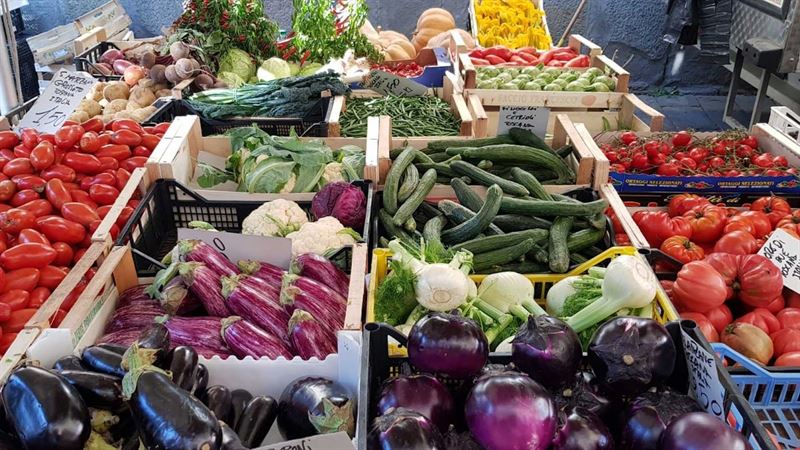
4. Browsing San Miniato markets
San Miniato markets are a pretext for tasting local foodstuffs and sensing the passing of the seasons in a town that is off the main tourist circuit. Most local markets and food festivals are lovely, whether held in San Miniato Alto (the Upper Town) or in San Miniato Basso (the Lower Town). For truffle-hounds, the finest feast is November’s White Truffle Festival, the Mostra Mercato Nazionale del Tartufo Bianco di San Miniato. Summer visitors can attend the Notte Nera (`the Black Night’ festival) in mid-June, which pays tribute the white truffle’s black twin. Black truffles may be less prized but are still wonderful, are better-priced, and work with a wider range of dishes.
If not around for a truffle experience, come for the weekly market on Tuesday morning, on Piazzale Dante Alighieri. Best of all is Il Mercatale di San Miniato, the Slow Food-approved farmers market.
Il Mercatale is the essence of San Miniato, an engaging farmers market that showcases the best local produce. Come for the scents, smells and lively atmosphere of this foodie market. On display is an array of fruit, meat, cheeses, honey, bread, pastries, olive oil and other local produce supplied by artisan producers in the surrounding countryside. Il Mercatale, also known as Il Mercato della Terra di San Miniato, is held on Piazzale Dante Alighieri on the third Sunday of every month. An antiques market, the Mercatino del Antiquariato, takes place on the first Sunday of the month.
-
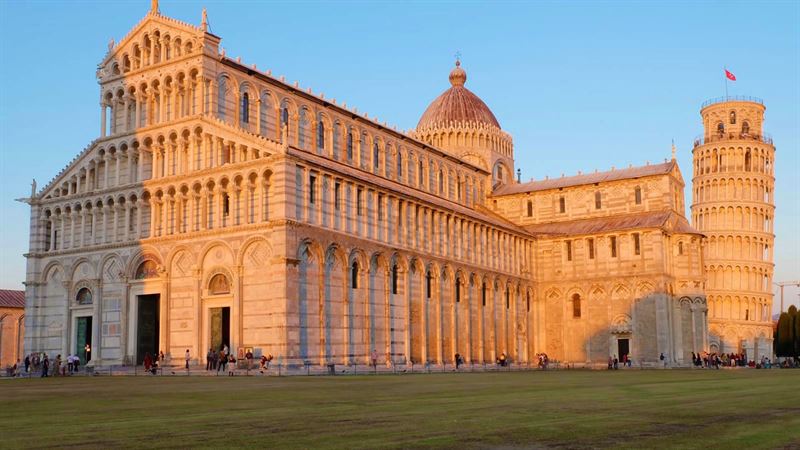
5. Pisa – more than the Leaning Tower
Pisa, 45 km west of San Miniato, and reached in under 45 minutes, makes for a perfect day trip. No city is as closely associated with one single monument as Pisa is with her Leaning Tower. It is a wondrous site but so are the Cathedral and Baptistery. Beyond this tourist-studded area, you will have much of Pisa to yourself. Unlike most Tuscan cities, Pisa's religious centre is not sealed inside the walls nor plonked in the old town but marooned on the northern edge of town. The star sights are clustered around the Campo dei Miracoli, a veritable Square of Miracles. Take in these celebrations of Pisan Romanesque and then explore the city itself. Or be radical: to avoid the photo-posing pandemonium, visit the town first and the Tower afterwards. Don’t restrict your visit to a selfie in front of the Leaning Tower. Spare a thought for the rest of Pisa, which is full of intriguing corners.
Begin with the Leaning Tower to salute one of Italy’s most famous monuments. Catch your first sight of the 12th-century Tower through the archway of the Porta Santa Maria, also known as the Porta Nuova. When the sun is shining, the whiteness daz¬zles; when raining, it glistens. The entire square, the Campo dei Miracoli, is studded with architectural treasures. Come to Pisa to take your fill of Pisan Romanesque, which was invented here. Pisa Cathedral, the Duomo, represents the glorious hybrid that is Pisan Romanesque. In form, it is austere Norman Romanesque but inspired by a Moorish Sicilian aesthetic and a Tuscan taste for marble. Yet the colourful geometry of the multi-coloured marble is essentially Tuscan. Also on the Campo dei Miracoli, a veritable Square of Miracles, stands Pisa Baptistry, the Battistero, the largest baptistery in Italy.
Clear you head with a walk along the riverbanks, known as the Lungarni. Also make time to stroll through the Borgo Stretto district for a sense of Pisan life. Pisa is not picturesque, and, beyond the `Field of miracles’, rarely tugs the heartstrings. But there is a warmer side to the city in the backstreets. The Borgo Stretto is a lively warren of alleyways and shopping streets between Piazza dei Cavallieri and the Arno riverbanks. Lined with cafes and shops, the arcaded Borgo Stretto opens out at Piazza Garibaldi and the Ponte di Mezzo bridge. It’s a perfect place for a wander in search of an ice cream, an afternoon coffee and cake, or a reasonably-priced meal. Call into the Pasticceria Federico Salza, an old-fashioned bar and pastry shop, set under the porticoes. It makes a tempting place for an afternoon coffee and cake or evening cocktails. For a full tour of Pisa, including restaurant and shopping tips, see our full Pisa guide.
Address: Torre Pendente (Leaning Tower), Piazza dei Miracoli, 56126 Pisa
Pasticceria Federico Salza, Borgo Stretto 46, 56126 Pisa
Tel: +39 50 835011
Web: www.opapisa.it -
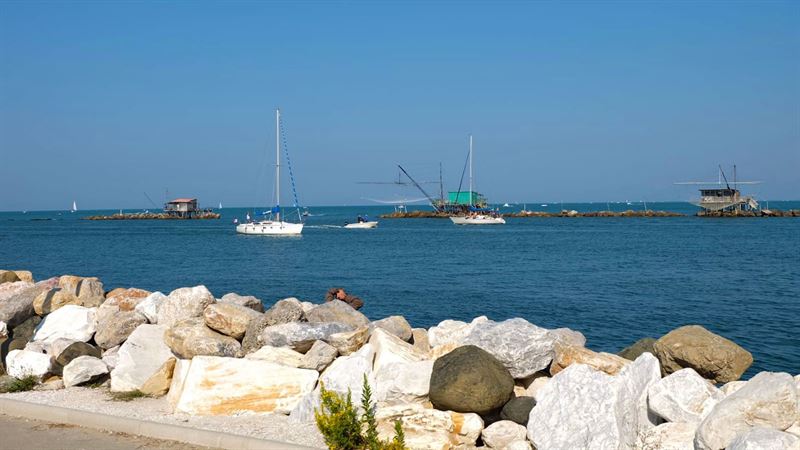
6. Marina di Pisa – for a seaside break
If you feel like a day out at the seaside, then you can reach the Pisan coat in under an hour’s drive. From San Miniato, follow the direct route west, which takes you just south of Pisa. From here, a pretty road follows the River Arno to the sea. About 6 km (4 miles) southwest of Pisa, it passes San Piero a Grado, a fine basilica which would once have overlooked the sea. Legend has it that this is the spot where St Peter first set foot on Italian soil. Once at the coast, 12 km from Pisa, you can visit the resort of Marina di Pisa, if only for a stroll along the café-lined promenade. If you’re lucky, there are distant views of the islands of Gorgona and Capraia. A stroll along the Lungomare (seafront) is particularly inviting in high season or on holidays when the promenade is closed to traffic. The seafront is lined with bathing establishments and beach restaurants. Feast on a fried seafood platter or the local speciality, spaghetti with tiny clams, known as pasta con le Arselle. The beaches, which range from sandy to pebbly, are now protected by breakwaters to combat erosion.
Just north of Marina di Pisa is the mouth of the River Arno, known as the Bocca d'Arno (or Boccadarno). It’s worth visiting the river estuary to see the strangely enveloping fishing nets called 'retoni'. This peaceful area marks the start of the extensive coastal parkland, the Parco di Migliarino, San Rossore and Massaciuccoli, which begins on the far bank of the river. In the same regional park is Pisa’s newish marina, framed by pine groves, and with views of the mountains. This Porto di Pisa was created in 2013 to give Pisa a proper marina and yacht club only ten minutes away from the city.
Tirrenia, 5 km further down the coast from Marina di Pisa, offers a stretch of pine forest, with the two resorts also linked by a bike path. Both Marina and Tirrenia are pleasant resorts but still underwhelming compared with the more upmarket Forte dei Marmi or Viareggio, both of which are further away, but still possible on a day trip, Still, if you’re sated of art and architecture, a beach break in Marina makes a pleasant day out, especially punctuated by a seafood lunch.
-
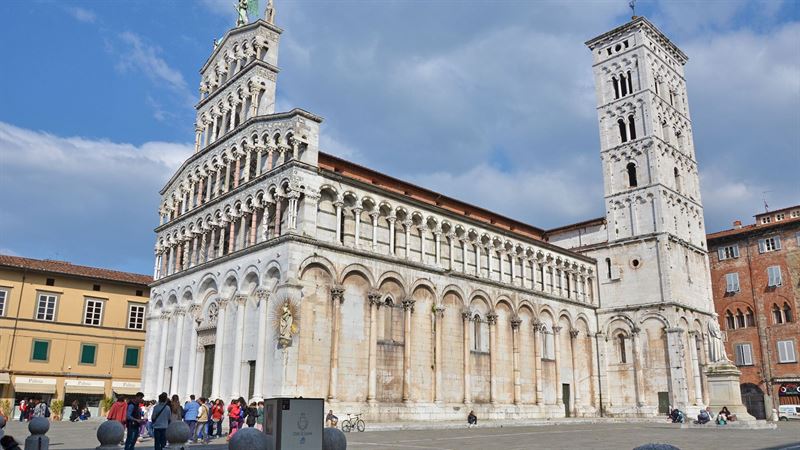
7. Lovely Lucca – a cultural capital in miniature
Lucca, 42 km west of San Miniato, and reached in around 50 minutes, makes for a magical day trip.
Lucca is a classic Tuscan city on a human scale, with just enough cultural attractions to beguile but not bewilder. Lucca is a cultural capital in miniature, with discreet bars and cosy inns, perhaps adorned with Art Deco mirrors. Dining out feels effortlessly civilised. Ringed by Renaissance walls, the city is made for leisure. The massive ramparts are now the place for jogging, flirting, gossiping and cycling – or several activities at once. The walls are a popular playground, promenade, jogging trail and cycle route. Every now and again, you can take the sloped exit down into town and cycle around the key sites, locking the bike up to a gate when walking around a piazza.
Roman Lucca survives in the grid-like design of streets, and in the elliptical Piazza dell’Anfi-teatro, still a centre of local life, even if now lined by townhouses. Ringed by pavement cafés, restaurants and souvenir shops, the amphitheatre is an atmospheric place to linger over an ice cream or even dinner. Leave through the opposite archway, following the curve of the amphi-theatre to Via Fillungo, Lucca’s main shopping street. Then visit the Domus Romana, a Roman home, complete with chance to discover Roman history and even sample Roman food, including focaccia with rosemary.
Lucca’s churches are gorgeous. The city churches are mostly Romanesque and inspired by Pisa. Yet, given city rivalries, Tuscan Romanesque delights in distinctive regional variations, as in the differentiated stripes and arcading in Lucca. The church of San Michele in Foro, built on the site of the Roman forum, must be one of the most spectacular Pisan-Romanesque façades in Italy. The city’s towers and mansions are equally beguiling. Climb Torre Guinigi, a 45-metre-high tower (with 230 steps) to admire rural views, and to make out the outline of Lucca’s Roman amphitheatre, perfectly framed by medieval townhouses. Palazzo Mansi, a 16th-century merchant’s mansion, is home to the Museo e Pinacoteca Nazionale which is full of Tuscan and Venetian masterpieces. Explore Palazzo Pfanner, a sumptuous mansion, complete with the Italian-style baroque gardens, designed for a wealthy merchant family. The countryside around Lucca is dotted with remarkable villas and gardens, notably the patrician Villa Torrigiani and Villa Reale, both surrounded by beautiful parks. To jaded urbanities, Lucca represents life as it should be led. Check our Lucca guide to see what appeals most.
-
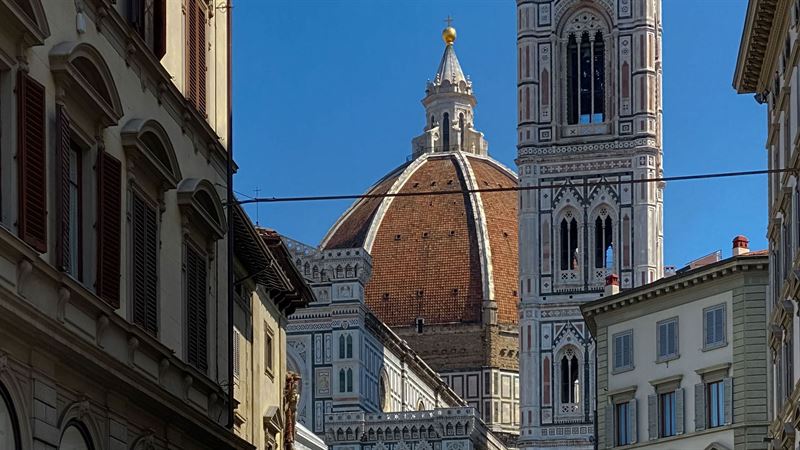
8. Art-filled Florence
Florence, 47 km east of San Miniato, and reached in just under an hour, makes for a culturally-packed outing. Despite devouring the checklist of must-see sights, steer clear of suffocating under the weight of treasures. Allow time for aimless wandering. Beyond the selfie sticks and statuary awaits a funky foodie haunt with sleek cafes, superb cooking and seriously edible markets. Florence is not fusty. Nor has the greedy city lost its gutsy Tuscan soul: traditional inns still serve earthy peasant fare, including macho steaks. Beware of trying to do too much on a day trip. Balance visits to galleries with wanderings in search of the perfect trattoria or the perfect view.
Begin in Piazza della Signoria, the city’s grandest square, with its copy of Michelangelo’s David and, beside it, the crenellated Palazzo Vecchio, with a well-presented collection. After a coffee at Rivoire, brace yourself for the Uffizi Gallery, the world’s greatest collection of Italian art. As such, the gallery is both a feast for the senses and an indigestible banquet so try and plan your visit in advance or even book a time slot online. After lunch, visit the Duomo, the biggest building for miles around. It is still Brunelleschi’s Renaissance dome that defines Florence. Out of respect for Brunelleschi’s achievement, the city forbade the construction of any building taller than the Duomo.
Clear your head in the Oltrarno, across the river Arno, where the Giardino Boboli (Boboli Gardens) act as an excellent antidote to the suffocating splendours of the Pitti Palace. The Medici dynasty created these statuary-encrusted gardens, which became the model for Italianate gardens for centuries to come. Before dinner, explore the Oltrarno neighbourhood's craft heritage on the so-called Left Bank of the city. This bohemian district is studded with stylish bars and buzzy inns interspersed with antique shops, jewellery-makers, picture-restorers and bijou art galleries.
Check our Florence guide to see what appeals most. If visiting a number of museums, consider buying a Firenze Card online (www.firenzecard.it) and also book a time slot at the Uffizi Gallery
-
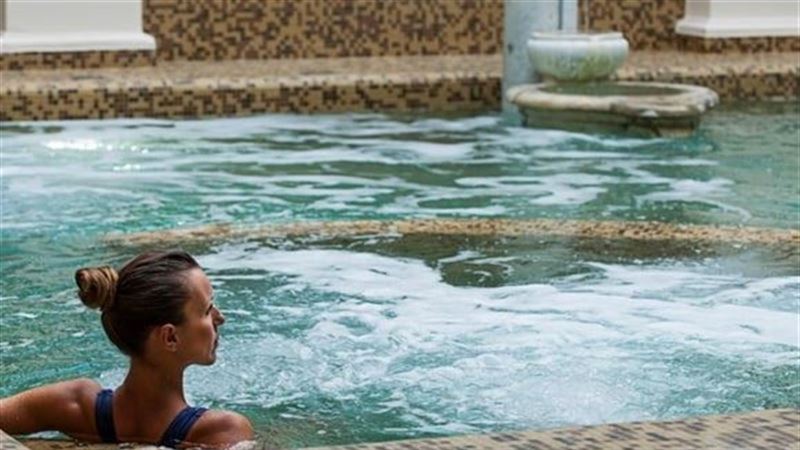
9. Bagni di Pisa – for revitalising hot springs
If suffering from cultural overload, consider a day out at Bagni di Pisa, the most upmarket spa close to the Pisan coast. Set in San Giuliano Terme, 44 km north-west of San Miniato, the spa is close enough to the coast to combine a spa outing with a coastal stroll and seafood feast around Marina di Pisa. The charmingly faded spa town of San Giuliano Terme lies midway between Pisa and Lucca, at the foot of the Pisan moun¬tains. Olives, chestnuts and pines grow nearby, while wild horses roam the hills. San Giuliano is renowned for the curative powers of its thermal springs.
Here, Bagni di Pisa spa resort is the best place to try out a thermal spa treatment, or simply indulge in some pampering. In its heyday, this atmospheric spa resort played host to the Romantic poets but is still romantic without them. These spa waters have been celebrated since Roman times and are especially good for the treatment of rheumatism and arthritis. Montaigne, Byron and Shelley were famous Grand Tourists who swore by such treatments. Even without any ailments, come for a day spa experience. Wallow in the hot springs and indulge in a treatment or two, including in a grotto pool. The spa experiences include lunch or dinner at the romantic Dei Lorena restaurant, with a distant view of the Leaning Tower of Pisa. Alternatively, consider the short drive west to the coast at Marina di Pisa for a seafront stroll or a seafood dinner. (For more, see the Marina di Pisa route above).
Address: Bagni di Pisa, Largo Shelley 18, 56017 San Giuliano Terme
Tel: +39 578 88501/ 57233
Web: www.bagnidipisa.com -
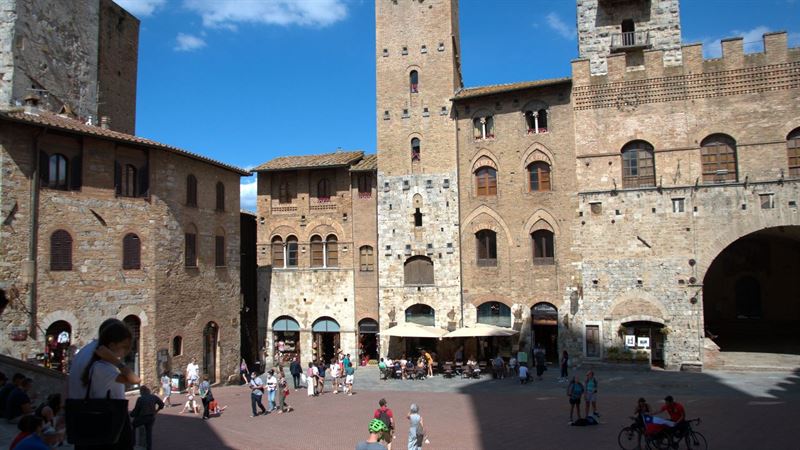
10. San Gimignano – medieval Manhattan
San Gimignano is only 39 km south of San Miniato so makes a worthwhile trip to see one of the medieval wonders of Tuscany. Given its spectacular setting, San Gimignano is one of the most touristy towns in Tuscany but manages to rise above the masses. With its moody medieval towers and walls, the town is one of the symbols of Tuscany. Building a lofty tower-house represented one-upmanship, medieval-style. The tower-studded skyline is one of the most spectacular sights in Tuscany. In its heyday, the city had a total of 72 towers, only 14 of which remain. Tower-houses were castle-residences serving as both warehouses and fortresses. A plague in 1348 wiped out much of the local population and the town slumbered as a backwater for centuries. The result is a medieval time capsule, even if the town is far from slumbering today. Its over-popularity and sometimes inflated prices are the only downsides but shouldn’t deter you from joining the throng.
The towers alone make a visit to this medieval time capsule worthwhile. Make time for Torre Campatelli, a true tower-house you can actually visit. This intriguing tower-house was home to the last resident of an illustrious Florentine clan. Apart from the medieval cityscape, the main sites are churches and public buildings. The best are congregated around the triangular Piazza della Cisterna and Piazza del Duomo. Here, the Palazzo Comunale is the forbidding fortress at the centre of city life since the days when Dante came on an ambassadorial visit from Florence.
Take a short walk along the city walls to la Rocca, the 14th-century fortress, before leaving town. This semi-restored fortress enjoys views over terraced gardens and olive groves winding down to the Vernaccia vineyards. The fortress is home to an enoteca, a wine-tasting experience, which traces the history of Vernaccia, the town’s most famous wine. You can even book a Vernaccia master class through the tourist office. If staying for longer, escape the crowds on a rural walk along stretches of the Via Francigena pilgrimage route outside San Gimignano. This is best booked through the tourist office. See our full San Gimignano guide for more.
Address: Museo Vernaccia, La Rocca, via della Rocca, San Gimignano
Tel: +39 577 941267
Web: www.sangimignanomuseovernaccia.com -
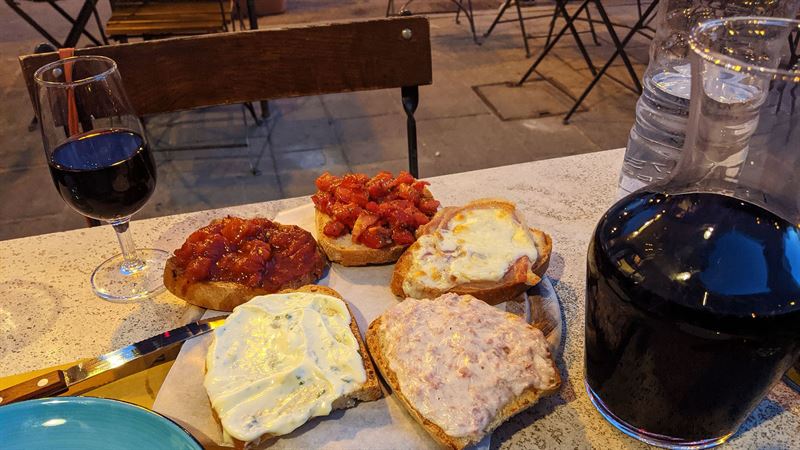
Eating & Drinking
Truffles are, of course, the main feast in town but most food in San Miniato follows the seasons and provides a pretext for any visit. The famed white truffles are best tasted during the November truffle fair and market, with a black truffle festival held in the summer. In late spring, generally in April and May, the prized San Miniato artichokes (carciofi), often served fried, appear on menus. Autumn inevitably means wild mushrooms and chestnuts harvested from the woods. Instead, the local goat’s cheese, formaggio di capra delle colline di San Miniato, is available all year round, as is succulent Chianina beef, Tuscany’s finest meat.
If lucky, your visit will coincide with a festival as San Miniato has a food festival for virtually every delicacy. The best local feasts include: the Sagra del Fiore di Zucca in early June, celebrating edible courgette flowers; the Sagra della Bistecca, the steak festival, in early July; and the Festa dell’Olio olive oil festival in early October. Best of all is the Sagra del Tartufo e del Fungo Porcino in the last week of September, celebrating truffles and ceps mushrooms. On November weekends, truffle fever reaches its peak, with a huge market and exhibition displaying the best truffles of the season. The great farmers market, Il Mercatale di San Miniato, is run under the auspices of Slow Food.
-
Pepenero
This stylish spot in the historic heart of town is a showcase for the culinary skills of Gilberto Rossi. This Veneto-born chef has made a name for himself in Tuscany and abroad, as well as nationally, on tv cookery programmes. Dine on modish Italian cuisine in this contemporary-looking restaurant with its brick vaulting and oak floors. Typical dishes include: marinated beef carpaccio; tortelli pasta stuffed with liquified Parmesan and mushy green peas; or suckling pig with turmeric and mashed potatoes. In white truffle season, dine on autumnal dishes that reflect the best of San Miniato’s finest crop. Tasting menus are designed for all tastes, including vegetarians. It’s worth doing one of the chef’s half-day cookery classes that end in a laidback lunch on your own dishes. Prices are mid to high, depending on the wine selection.
Address: Via IV Novembre 13, 56028 San Miniato
Tel: +39 571 419523
Web: www.pepenerocucina.it -
La Taverna dell’Ozio
Truffles, both white and black, reign supreme in this trusted, unpretentious, family-run inn. After antipasti of crostini, cured meats or verdure sott’olio (vegetables preserved in olive oil), starters could include pasta with game sauce or, of course, truffles. A truffle-related first course could be ricotta-and-walnut stuffed crepes (pancakes) in a truffle sauce. A main course might feature steak in a black pepper and truffle sauce. If truffles are not to your taste, then try the steaks or the hare in a chocolate sauce. Best to book well in advance as this cosy place is often full.
Address: Via Zara 85, 56024 Corazzano, San Miniato
Tel: +39 571 462862 -
Birra e Acciughe
Named `Beer and Anchovies,’ this cheap and cheerful pub delivers on both fronts. This friendly, pocket-sized pub serves creative sandwiches, including with truffle and honey, anchovies and chilli, or anchovies marinated in beer. As for drinks, it’s craft beer, of course, ranging from Italian lager to Belgian white beers or English ales.
Address: Via Augusto Conti 29, San Miniato 56028
Tel: (+39) 329 0026905 -
Sergio Falaschi
This is a typically Tuscan model: a renowned butcher’s shop doubling as a tasty, rough-and-ready inn. At the back of the ceramic-tiled butcher’s is a fuss-free inn specialising in T-bone steak made from the best Chianina beef, blood sausages and cured meats such as wild fennel salami or cinta senese, specialised Tuscan port from back Sienese pigs. Also sample the sausages made with white truffle from the San Miniato hills. Many of the pigs are raised in a semi-wild state, ensuring quality meat.
Address: Via Augusto Conti 19-20, San Miniato 56028
Tel: +39 571 43190
Web: www.sergiofalaschi.com -
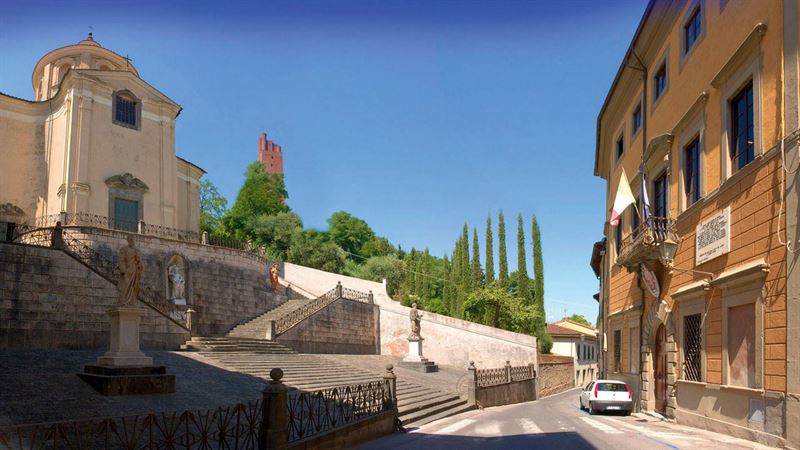
Shopping
Shopping for foodstuffs, especially for cured meats or truffles, is an enticing activity. The white truffle season runs from mid-September to Christmas but peaks in November. These famed white truffles can be bought at the November truffle fair and market, with a black truffle festival held in the summer.
-
Coop supermarket
Set in San Miniato in Basso (the Lower Town), this well-stocked supermarket includes butchery and bakery sections.
Address: Via Ferrante Aporti 10-12, 56028 San Miniato
Tel: +39 571 403499
Web: http://www.coopfirenze.it/punti-vendita/san-miniato- -
Tartufi Nacci
Located in Corrazzano, outside San Miniato, these family-run truffle suppliers provide an entrée into the secret world of truffle hunting. Come for a wide range of truffle produce, including truffle oils. Visit them before having lunch in La Taverna dell’Ozio.
Address: Via Zara 110, Localita Corrazzano, 56024 San Miniato
Tel: +39 571 462846
Web: www.tartufi-nacci.com -
Lo Specchio Magico
The quirky San Miniato gift shop specialises in one-off pieces made from glass bottles, including recycled glass. The results can be ornamental objets d’art, colourful knick-knacks or jewellery.
Address: Via Augusto Conti 30, 56028 San Miniato
Tel: (+39) 571 961356 & (+39) 348 2921516 -
Parking
Bear in mind that San Miniato is a town of two halves: San Miniato in Basso, the Lower Town, and arrival point; and San Miniato (also known as San Miniato in Alto). This, the Upper Town, holds the greatest concentration of attractions. Parking is generally ample, with a paying car park at the top of the hill, convenient for the Upper Town. If arriving by train, note that a free bus regularly connects the railway station (in San Miniato in Basso) with San Miniato in Alto.
Most Tuscan towns operate a strict ZTL system, a Limited Traffic Zone. This means that the Centro Storico (historic centre) is essentially closed to traffic, particularly for non-residents. Cars will need to be left outside the walls. Advice on ZTLs: You may see other cars crossing the ZTL boundary (Limited Traffic Zone) and assume you can proceed. Not so. The drivers crossing into the ZTL zone will probably be locals and have residents’ permits. Visitors do not so are liable to fines. Zones are monitored by cameras, so tickets are issued immediately and automatically, as soon as (and each time) the car crosses the ZTL boundary. For more, see www.comune.san-miniato.pi.it -
Getting there & getting around
By car: You will probably be arriving along the Firenze-Pisa-Livorno road (often dubbed the FI-PI-LI). If so, take the San Miniato exit. Follow signs for San Miniato in Alto, which first leads to San Miniato in Basso, the Lower Town.
By train: San Miniato station is in San Miniato Basso, the Lower Town. You can also arrive by train, leaving Firenze Rifredi or Pisa Central, get off at San Miniato-Fucecchio and then catch the local bus which will take you to the hilltop, a rather steep walk. San Miniato is on the line to Prato (a 15-minute journey); Florence (a 45-minute journey); Lucca (around an hour); and Pisa (around two hours).

























